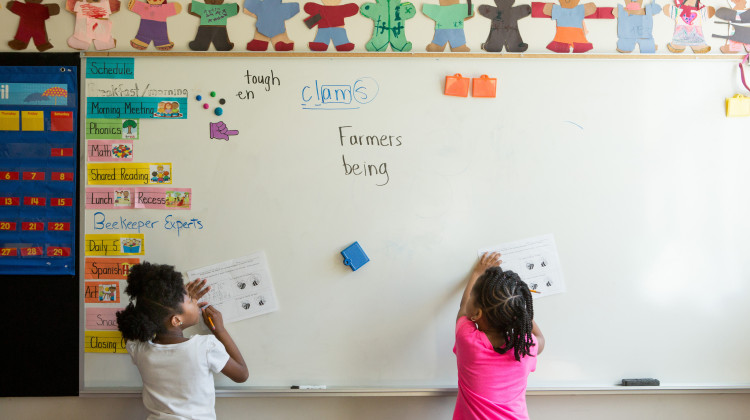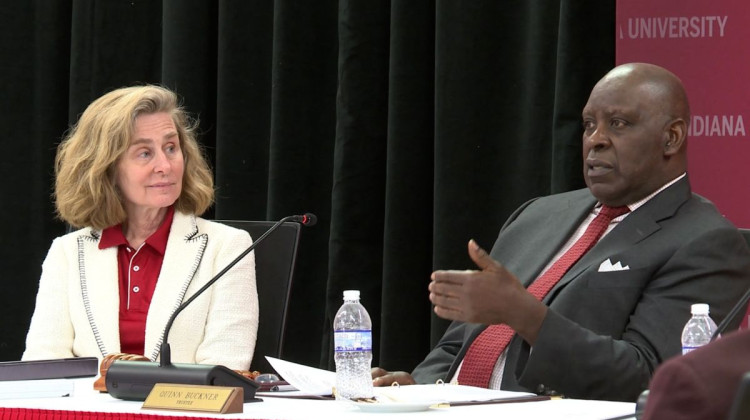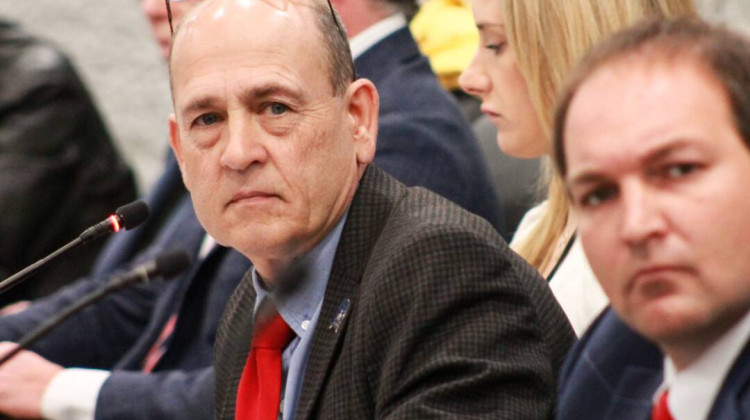
K-12 schools will receive a 2% increase each year of the biennial budget, which includes universal private school vouchers for all Indiana families in mid-2026.
Allison Shelley/The Verbatim Agency for EDUimagesUpdated 2:33 a.m., Friday, April 25, 2025
Indiana public school funding was mostly spared from cuts in the state’s two-year budget, even as lawmakers expanded private school vouchers.
Legislative leaders still found a way to expand vouchers to private schools despite the state’s latest revenue forecast that showed a $2 billion drop in expected revenue across the biennium.
The unexpected drop in revenue led to a 5% trim across state agencies and departments, with deeper cuts to public health and some education-related programs, including adult education, the Indiana School for the Deaf, and the Department of Education.
K-12 education accounts for about 47% of the $46 billion biennial budget. Schools will receive a 2% increase each year of the biennial budget, which includes the expansion of vouchers to private schools in the second year starting in mid-2026. The increase also folds in $160 million to cover curriculum materials, such as textbooks, which schools previously received through separate funding.
Republican lawmakers unveiled their final budget proposal Wednesday evening, with the final approval coming just after 1 a.m. Friday. Gov. Mike Bruan is expected to sign it.
Budget architect Jeff Thompson (R-Lizton) said expanding choice was “very, very important” and funding K-12 was an investment in the future.
"K-12, the commitment to education will affect people in the next century," he said late Thursday.
Thompson and Republican leaders touted an increase of $640 million – or about 5% over the biennium – to state tuition support.
The budget follows a new property tax relief law signed April 15 that could cost school districts $744.4 million over the next few years.
But the most sweeping change is the expansion of Indiana’s Choice Scholarship Program to all families, regardless of income. The new law eliminates the last remaining income eligibility requirements for private school vouchers.
Voucher use in the state is at an all-time high with more than 70,000 students enrolled. Those vouchers cost the state about $439 million in tuition grants to private schools.
When vouchers are universal, the estimated cost in tuition grants to private schools will be $674 million.
Betsy Wiley, President & CEO of the Institute for Quality Education, celebrated the final budget that “made universal school choice a reality for all Hoosiers”.
“HEA 1001 continues the trend of empowering parents and students to make the best educational choices for themselves,” Wiley said in a statement for the organization, which advocates and promotes private school vouchers, charter schools and other choice options.
But the Indiana State Teachers Association expressed concern.
“We remain concerned about the expansion of private school vouchers to the wealthiest families, particularly as public schools continue serving the vast majority of Hoosier students,” ISTA wrote.
A 2023 law removed most eligibility requirements for students, like previous enrollment in a public school, and now allows upper-income families to use public money to help pay for a private-school education.
Despite a split between Republican leadership on the expansion of private school vouchers, the Choice Scholarship Program will be opened up to all families regardless of household income. It’s expected to cost more than $190 million to grow the program over the biennium, according to a state projection.
Rep. Andrea Hunley (D-Indianapolis) said it’s not a “prudent time” to expand vouchers will only help wealthy families.
“We know that who's going to benefit are the wealthiest families in the state,” Hunley said. “Families who are making well over four hundred, five hundred thousand dollars a year are now going to get state aid to send their children to school.”
House Speaker Todd Huston (R-Fishers) said this year’s budget continues to support K-12 education in “every way”.
“Even with a surprise shortfall in revenue we made sure we protected K-12,” Huston said. “And yes, yes yes, yes we are providing all parents a choice.”
Here are five more parts of the state’s budget that impact schools, and start July 1.
Vouchers for students with disabilities, career training remain funded
Education Scholarship Accounts, or ESAs, which provide money to families of students with disabilities, serves more than 1,000 students. The program is only open to families who leave the public school system
Although ESAs remain funded, the program will receive far less than Braun desired as his budget boosted them to a $30 million cap. In the presumptive budget, ESAs receive $10 million each year, a slight drop in funding per year.
But there’s more funds for Career Scholarship Accounts, or CSAs, that provide money to students so they can pursue their career interests through internships or job training.
CSAs will continue to receive $10 millions annually, which bumped up from $5 million to $10 million over this last budget cycle.
In the second year of the budget, oversight of both ESA and CSA programs will shift from the State Treasurer’s office to the Department of Education. Both programs distributed all their funds to participating students this school year.
Funding for virtual schools stays put
Funding for virtual schools remains unchanged. Lawmakers kept their per-student funding at 85% of the amount received by traditional public school students, after the Senate resisted a House proposal to raise the rate to 100%.
Sen. Ryan Mishler (R-Mishawaka) said the Senate’s move was because of tight funds and concerns surrounding virtual programs.
“There just seems to be a lot of issues with some of the virtual school programs,” Mishler said. “We need to get a handle on that before we consider increasing any of that.”
Charter schools make gains but lose on capital grants
Charter schools will begin to receive property tax funding from traditional public schools, due to legislation added to the state’s property tax plan.
The move is expected to give charter schools about $4.7 million in the first year.
Unlike traditional public schools, charter schools for the most part do not receive local property tax revenues.
The Charter and Innovation Network School Grant, which provides additional state aid to charter schools, remains funded at $52.6 million annually. But a separate $25 million fund created in the last budget to help charters pay for facilities and leases was not renewed.
School safety grants, office doubled in funding
The Office of School Safety – established by Braun early in his tenure – takes home more than $1 million annually to oversee and steamline various safety initiatives, including grants to schools.
Braun found previous plans for school safety “fragmented” across different legislative offices, according to his agenda.
“As modern threats continue to grow in complexity, the State must ensure that local communities and schools are supported so that no aspect of school safety falls through the cracks,” the agenda reads.
Last year, the now-replaced Indiana’s Secured School Safety Board approved more than $24 million in spending for safety measures in schools. Those grants increased to $27 million in each year of the final budget.
More than 400 different schools were approved to use that money for needs like school resource officers, equipment and student support services programs. Seven schools also used those funds to train teachers who carry firearms on campuses.
$100 million earmarked for Gov. Braun education initiatives
The budget also sets aside $100 million for the governor’s new Freedom and Opportunity in Education Fund. The fund is designed to boost academic outcomes and support new classroom initiatives. It will support:
- A statewide expansion of the ILEARN checkpoint pilot;
- A new interactive advising tool for the state’s updated diploma requirements;
- Teacher recruitment in high-need areas such as special education, STEM and English learner instruction;
- Dropout prevention programs;
- Literacy achievement and computer science programs; and
- Evidence-based reading interventions and literacy grants.
The new two-year budget takes effect July 1.
Rachel Fradette is the WFYI Statehouse education reporter. Contact Rachel at rfradette@wfyi.org.
 DONATE
DONATE








 Support WFYI. We can't do it without you.
Support WFYI. We can't do it without you.